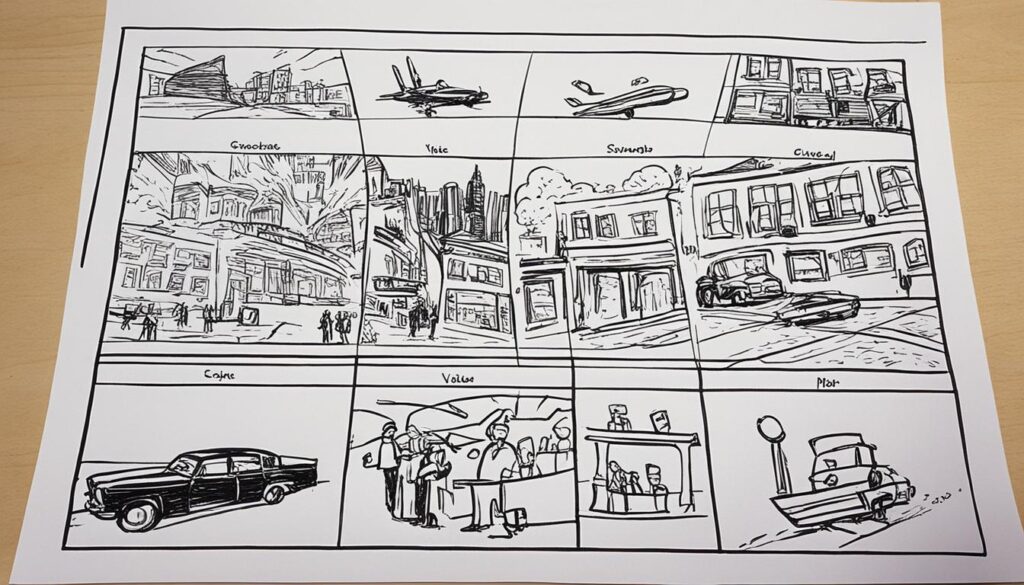Animated Explainer Videos: Tips for Script Writing
Making an animated explainer video is a great way to share information interestingly and memorably. But even with great visuals, a bad script can make your video dull or hard to understand. So, having a strong script is key for your video to succeed.
An explainer video uses Allan Paivio’s Dual-Coding Theory. This theory says that people understand better when they get information through both seeing and hearing. By putting together a good script and great animations, you can explain complex ideas in a way that grabs your audience.
In this piece, we’ll talk about why a good script is important for explainer videos. We’ll give you helpful advice on writing a script that works. You’ll learn how to tell your story, add emotion, and make a strong call to action. We’ll help you make a script that connects with your audience.
Key Takeaways:
- A good script is crucial for the success of an animated explainer video.
- Explainer videos combine audio and visuals to enhance understanding.
- Writing a good script involves distilling your story and engaging the audience.
- Showcasing emotion and maintaining the right pacing are essential.
- A strong call to action should be included in every explainer video script.
Why Your Explainer Video Script Matters
Explainer video scripts are vital for both the audio and visuals of a video. The script’s quality decides if the video succeeds or fails.
Explainer videos aim to grab viewers with a clear story. You must pick the story you wish to tell and share it simply.
A good script sets the scene, offers a solution, and gives viewers something to remember. By making a good script, your video will share your message and catch your audience’s attention.
How to Write a Good Explainer Video Script
Writing an effective explainer video script involves two important parts: the story you want to tell and how you tell it. To make a script that stands out, you should follow some essential steps.
Step 1: Identify Your Story
The first step in crafting an explainer video script is to pick the story you wish to share. Think about why this story matters to you and your viewers. Knowing this will shape your scriptwriting.
Step 2: Distill Your Story
After you’ve chosen your story, simplify it. Explainer videos should get to the point fast, so keeping things brief is crucial. Make complex ideas easy to grasp with short sentences.
Step 3: Engage the Viewer
As you write your script, talk directly to your audience. Use words that speak to them and pull them into the story. This approach makes your video more engaging and effective.
Step 4: Add Emotion and an Engaging Hook
Add emotion and craft an engaging hook to grab your viewers’ attention immediately. Connecting emotionally can make your story stick with your audience, whether through humor, inspiration, or empathy. Start with something that makes them need to keep watching.
Step 5: Craft a Strong Call to Action
Every explainer video needs a clear call to action. Tell viewers exactly what you’d like them to do next. This could be visiting a site, signing up, or buying something. Your call to action should inspire them to move forward.
By applying these steps, you’ll be able to write a compelling explainer video script. Such a script will not only convey your message but also captivate your audience.
| Benefits of a Well-Written Explainer Video Script | Steps to Write a Script |
|---|---|
| 1. Clear and concise communication | 1. Identify your story |
| 2. Engages and captivates the audience | 2. Distill your story |
| 3. Positions your brand effectively | 3. Engage the viewer |
| 4. Drives viewer action | 4. Add emotion and an engaging hook |
| 5. Enhances brand credibility | 5. Craft a strong call to action |
Tips for Distilling Your Story
Creating an effective explainer video script means you need to simplify your story. It’s about making complex ideas clear and easy to understand. This way, your audience can quickly grasp what you’re saying.
Here are steps to make your story clear and impactful:
1. Use short, simple sentences
Write in brief, clear sentences. Long, complex sentences can confuse viewers. Short sentences help you share your ideas more effectively. This keeps your audience interested in your video.
2. Maintain a friendly tone
A welcoming tone helps viewers connect with your story. Don’t use hard-to-understand words or jargon. Instead, choose words that are friendly and easy. This lets viewers easily get and relate to your message.
3. Stay focused on the main story
Don’t add too much detail to your script. Stick to the main idea you want to share. Leave out extra info that could distract your viewers. A focused story helps viewers understand your message clearly.
4. Consider the visuals and music
Think about the visuals and music while writing your script. The visuals should match your story and support what you’re saying. Likewise, the right music can set the mood. These elements together can make your video more engaging.
Distilling your story takes thought and care. By simplifying ideas, using clear words, and staying focused, you can make a captivating video script. Remember, the aim is to make your story easy for viewers to understand and connect with.
Incorporating Emotion into Your Script
Emotional storytelling is very powerful. It connects you with your audience on a deep level. Using humor, anecdotes, or relatable situations in your explainer video script can make this happen.
Showing your brand’s personality helps a lot. It makes you seem like a helpful and approachable friend. When your stories resonate with viewers, you create an emotional bond. This bond increases engagement and loyalty.
It’s key to find the right balance of emotion in your script. The emotion must fit with your topic and your brand’s overall tone. It should help convey your message and not distract your viewers.
“The secret to creating a memorable script lies in weaving emotional threads throughout your story. By tapping into your audience’s emotions, you can create a connection that will make your video resonate with them long after it ends.” – Marketing Expert
The goal is to captivate and engage your audience with emotional storytelling. Connecting with them emotionally can leave a strong impression and inspire them to act.

Ensuring the Right Length and Pacing
Keep explainer video scripts short and to the point. Don’t add extra info that’s not needed. Aim for a 30-second to 3-minute length, based on the topic’s complexity. This way, you grab your audience’s focus and get your point across well.
The pace matters a lot too. Try for 125-150 words per minute. This speed makes sure your script is easy to follow. Your audience won’t feel lost or bombarded with too much info.
Reading your script out loud is a good tip. It lets you spot parts that are too quick or drag on. Then, you can tweak things to get the flow just right.
How long and fast your explainer video is can make or break it. Keep it short, within the suggested time, and at an easy pace. This keeps people watching and listening.
Adjusting for Voice Over
Creating an explainer video script means thinking about the voice over. The voice over adds a human touch, making the video better. It’s key to tweak the script for a good voice over.
Use language that’s easy to say for a smooth voice over. Avoid hard words or jargon that could confuse the voice actor. Try to keep a friendly tone that your audience will like.
If sentences sound strange or don’t flow well, change them. Make complex ideas simpler and use natural speech. This makes the script easy and natural to voice.
Voice over artists might see the script differently than you do. Be open to changes that make the script sound better when spoken. This lets the voice artist add their unique touch, making the video better.
Working on the script for voice over is about teamwork. It requires clear talking and direction for the voice actor. A script that feels natural and allows creativity leads to a great voice over.
Show, Don’t Tell
Visual storytelling is key in making explainer videos impactful. It’s crucial to show your message, not just tell it. This helps viewers grasp your content better.
Use visuals and animations instead of just words to explain things. This grabs your audience’s attention and helps them remember what you’ve said.
To really connect, use visuals that match your script. Visual storytelling engages both sight and hearing, making your message strong and memorable.
The aim is to draw in your audience with great visuals. This way, you make a stronger impact and your message sticks.

Enhancing Engagement Through Visuals:
- Utilize animations and illustrations to simplify complex ideas
- Demonstrate step-by-step processes visually to enhance understanding
- Use infographics and charts to convey data and statistics effectively
- Showcase real-life examples or case studies to make concepts relatable
“Visual storytelling allows you to tap into the visual and auditory channels simultaneously, creating a more immersive and memorable experience for your audience.”
With visual storytelling, your explainer videos become more engaging and impactful. Visuals can convey messages powerfully, stir emotions, and prompt action.
Proofreading and Editing Your Script
After you’ve written your script for the animated explainer video, you’re not done yet. Proofreading and editing are crucial to make your script clear, concise, and error-free. This step helps you refine your script, ensuring it clearly delivers your message to the audience.
Start by reading your script out loud to yourself or someone else. This makes it easier to spot awkward phrases, pacing issues, or unclear parts. Take note of anything that interrupts the flow or could be clearer.
Getting feedback from others is also a good idea. They can offer new insights and point out things you might miss. Use their feedback to make your script even better.
When editing, keep your story and message in mind. Make sure your script meets your video’s goals and communicates your key points well. Go through your script line by line. Modify it as needed to make it clearer and more impactful.
| Proofreading Checklist | Editing Checklist |
|---|---|
|
|
The main goal of proofreading and editing is to improve your script, making sure it clearly gets your message across. Try to make your script as engaging and easy to follow as possible. Putting in the effort at this stage will greatly improve your explainer video script.
Crafting a Strong Call to Action
Every good explainer video script must have a strong call to action. This part is crucial because it pushes the viewer to do something after watching. This could be visiting a website, signing up for a trial, or calling sales.
Your call to action should match your video’s main message. Keep it simple and straightforward, telling viewers exactly what to do. Persuasive words can motivate them, showing the perks of taking action.
Using emotional triggers in your call to action can spark urgency or excitement. Phrases like “now,” “limited time,” or “exclusive offer” get people moving. It should speak directly to your audience and cater to their wants and needs.
It’s also vital to make your call to action easy to see. Use bold colors, big fonts, or special visuals to catch the eye. Animated effects might also make your call to action pop out more.
Increase your conversions and engage your audience with a compelling call to action in your explainer videos. Encourage action, inspire curiosity, and create a sense of urgency. Craft a call to action that not only grabs attention but also motivates the viewer to take the next step.
Examples of Effective Call to Action Phrases:
- Sign up now for a free trial and unlock the full potential of our product!
- Visit our website to learn more and start your journey towards success today!
- Contact our sales team for a personalized demo and see how our solution can revolutionize your business.
- Unlock exclusive content by subscribing to our newsletter. Stay updated and ahead of the competition!
Remember, a strong call to action is vital for driving conversions from your explainer videos. Spend time making yours compelling and persuasive. If it aligns well with your video and reaches out effectively, it can truly inspire action and have a lasting effect on your viewers.
Conclusion
Writing a great explainer video script takes a lot of thought. You need to think about the story, who will watch it, feelings, and rhythm. Follow the tips in this article to make a script that catches attention and shares information well.
Keep the main story in focus, highlighting the important message. Use images and drawings to make things clearer and more engaging. Adding emotion makes the connection with viewers stronger and matches their interests and needs.
Don’t forget a strong call to action at the end. It could be visiting a website, signing up, or getting in touch with sales. A good call to action can boost conversions and meet your video’s goals.
A well-crafted script makes your animated explainer video stand out and captivate audiences. Keep these final tips in mind and start writing your script now.







